
The dominance of the largest technology stocks, deemed the ” Magnificent Seven ,” in this Wall Street rally has led to worries about valuations and has drawn more than one comparison to the tech bubble of 1999. But a closer look at those companies, ranging from Amazon to Microsoft to Nvidia , can also lead to another, possibly unexpected, conclusion: They may actually be the strongest part of the market, especially if the economy cools. While it’s true that only a handful of stocks with sky-high price-to-earnings ratios have led the market to new highs, the earnings effect of those companies has also been significant and looks to be getting bigger. “Mega-cap tech firms accounted for a record high 23% of [S & P 500] earnings in Q4,” Ajay Rajadhyaksha of Barclays said in a note to clients last week. “In other words, while Big Tech is 30% of the index, it is also a very large part of earnings. Moreover, EPS for the six largest technology firms (by market cap) was up a stunning 60% y/y. And margins have continued to expand, and are now nearly 25%,” said the bank’s global chairman of research. .SPX 1Y mountain The S & P 500 closed at a record high on Wednesday, though this bull market has been driven by just a handful of stocks. As a result of this earnings growth, the relative valuations of the market’s biggest companies aren’t terribly different than their smaller peers, even if they are elevated compared to historical averages. “The top 10’s [price-to-earnings ratio] is 2.6 standard deviations above its long-term mean, but the other 490’s P/E is 1.8 standard deviations above,” Ed Clissold, chief U.S. strategist at Ned Davis Research, said in a recent note to clients. The market rally has started to broaden a bit, which could narrow that gap even further. While the S & P 500 rose to a new high on Wednesday after the March update from the Federal Reserve, it was the small-cap Russell 2000 that saw the bigger gain for the day, jumping nearly 2%. Optimistic strategists, such as Fundstrat’s Tom Lee , see the market rally continuing to broaden. But with the Federal Reserve slow to cut rates, a “higher for longer” rate environment may eventually weaken the economy and make the premium for Big Tech worth the cost, according to Cayla Seder, a macro multi-asset strategist at State Street. “We should be in an environment where earnings are pressured. So we want to be in those areas that can actually deliver earnings,” Seder said in an interview. Seder said her team’s preference is less for tech stocks, specifically, than it is for large-cap quality growth, a category that happens to include many of the biggest names, such as Nvidia and Microsoft . If the economy does slow with rates remaining high, as Seder expects, concentrating on those Big Tech stocks could end up being a good thing for the U.S. market. “The sector makeup of the U.S. is kind of like the saving grace, I think, because it’s still large cap quality growth and we’ve seen these companies be able to still, in some places, thrive in that environment,” Seder said. The gap in earnings expectations does not mean that the cash-rich tech stocks won’t come back to earth eventually. UBS strategist Jonathan Golub said in a note to clients on Wednesday that the Big Tech rally was on “borrowed time.” While he agreed with the idea that tech’s earnings growth has kept valuations reasonable, he threw cold water on the idea that the growth could continue. “While upward revisions are currently supporting these companies, the deceleration in future profits cannot be ignored,” Golub wrote.






